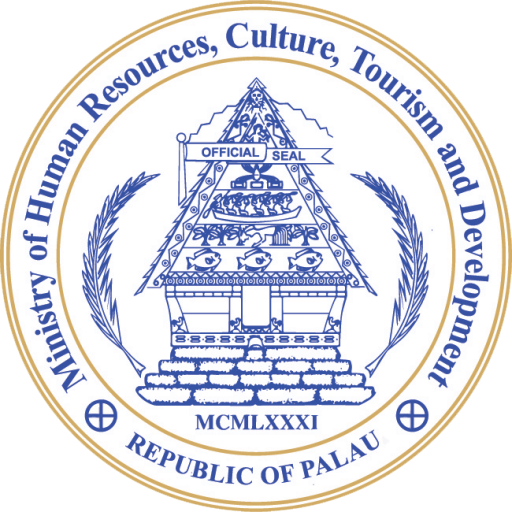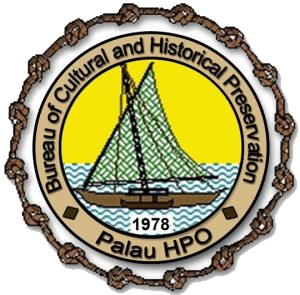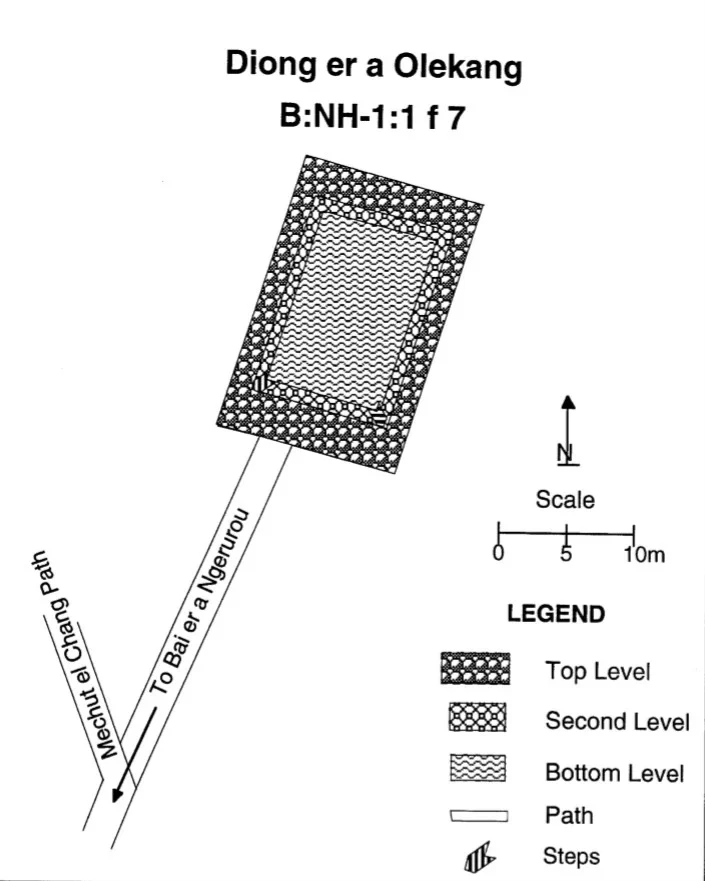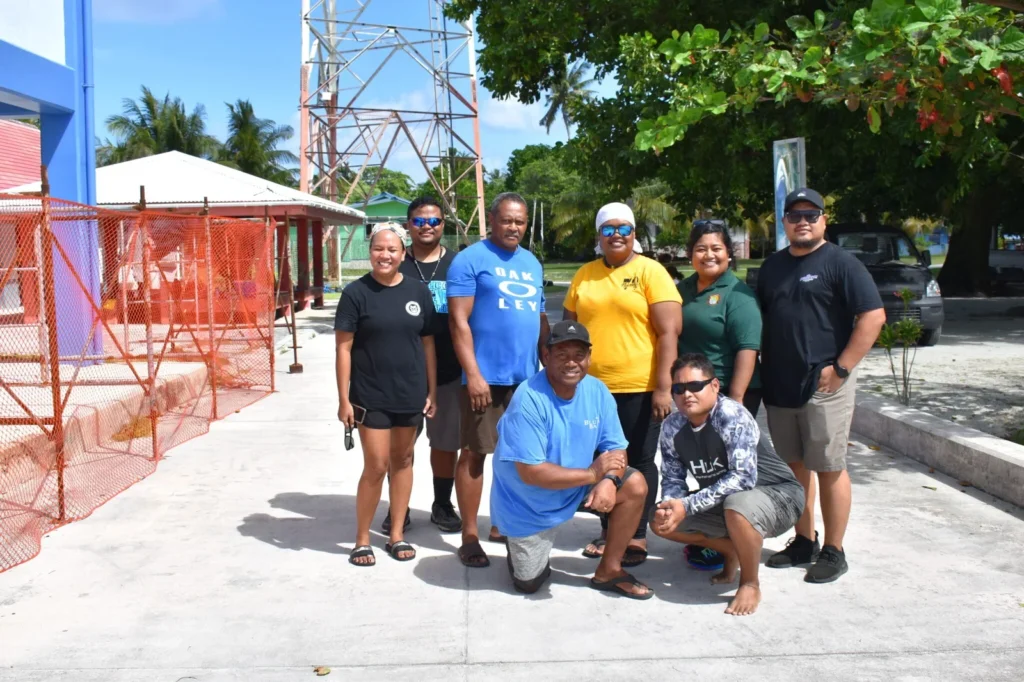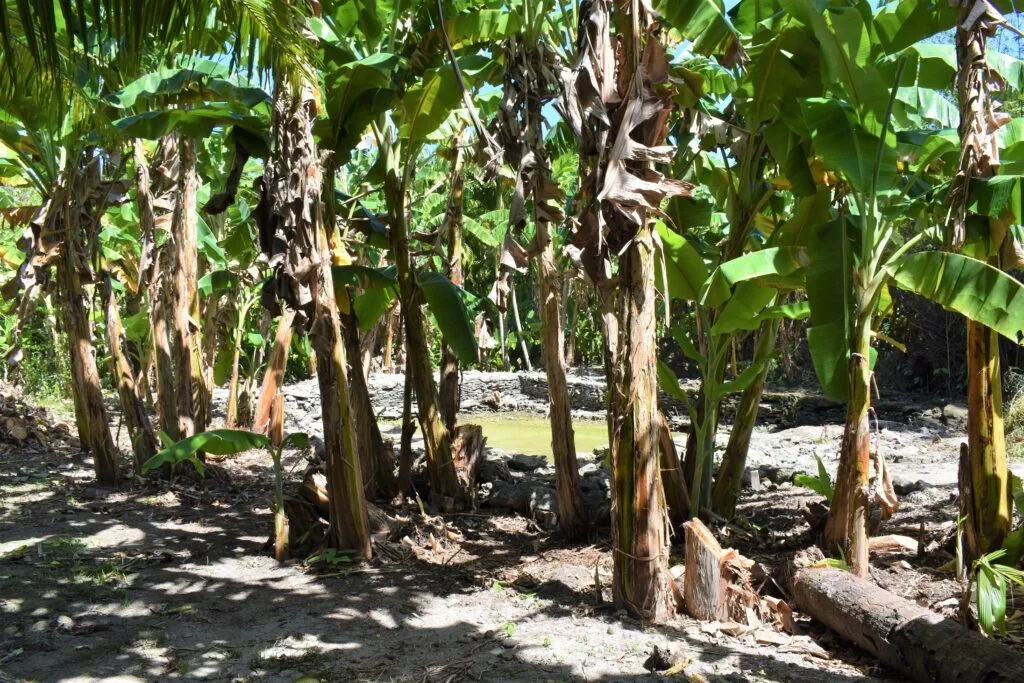Photo by McMichael Mutok Jr. (August 2024)
Diong er a Olekang
Traditional Bathing pool of Ngerdimes
- Kayangel
Site Type
Date Registered
Site No
History
In recognition of its significance, Diong er a Olekang site number B:NH-1:1 Feature 7 has been listed in the Palau Register of Historic Places on September 02, 1999. Through preservation, study, and interpretation, the site can serve to educate future generations concerning the historical and cultural heritage of the Palauan community and the state of Kayangel.
Diong er a Olekang is a large bathing pool for the chief’s of Bai er a Ngerurou located in Ngerdimes, one of the four regions of Kayangel. It is one of the biggest bathing pools ever constructed in the state of Kayangel and is in excellent condition. Diong er a Olekang is paved with stones along the edge of the pool with a similar architectural design to bathing pools located in Babeldaob, but it was constructed in coral slabs because there is no basalt rocks in Kayangel.
The island of Kayangel is an atoll island with limited water resources, so the people of Kayangel in the past worked together to build bathing pools to conserve water and serve the people.
This bathing pool is not only for the chief’s of Bai er a Ngerurou but also for the village of Ngerdimes. There is an old stone pathway from Bai er a Ngerurou toward Diong er a Olekang called Mechut el Chang.
It is important to preserve and protect this significant site called Diong er a Olekang to prevent it from being destroyed or abandoned. This site holds irreplaceable tangible cultural heritage that represents its uniqueness to the state of Kayangel and its people.
This bathing pool is not only for the chief’s of Bai er a Ngerurou but also for the village of Ngerdimes. There is an old stone pathway from Bai er a Ngerurou toward Diong er a Olekang called Mechut el Chang.
It is important to preserve and protect this significant site called Diong er a Olekang to prevent it from being destroyed or abandoned. This site holds irreplaceable tangible cultural heritage that represents its uniqueness to the state of Kayangel and its people.
CHELDECHEDECHAL
Tia el olsechall el Diong er a Olekang el Site Number B:BH-1:1 Feature 7 a siliseb er a omsengelel a klalo er a Ibetel a Cherechar (Palau Register of Historic Places) er se er a September 02, 1999. Tia el olsechall a ta er a mekreos el ibetel a cherechar er a Belau, el kmal klou a ultutelel el olsechall el mo er a rechad me a beluu er a Ngcheangel.
A Ngcheangel a chelechol el beluu el kesiokel a ralm er ngii, a uchul me a rechad er a Ngcheangel er a irechar a mle blak a rengrir el meruul aika el diong er a beluu el omech er a chelebulel a beluu. Me tia el Diong er a Olekang a diak el di ble el disechir a re Ngarurou el klobak er a Dimes e le merekong, ng dirrek el beluu er a Dimes a uluusbech er ngii. Ngar er ngii a cheldukl el bad el rael er a irechar el ngar er a Bai er a Ngerurou el merael el mo er a Diong er a Olekang. A rechad er a Ngcheangel a omekedong er ngii el kmo Mechut el Chang.
A taem er a Siabal er a Belau el me lmuut er a 1950’s e a rechad er a beluu er a Ngcheangel a dirk el uluusbech aika el cheldukl el diong er a irechar er a beluu er a Ngcheangel. A uriul er a le bo er ngii a dromukang me a lmuutel bebil er a teletelel a omeruul el blil a ralm er a derta el obliil, e ngii a mirrael el mo diak a usbechel tia el Diong er a Olekang er a bekord el ngar er a 1955.
Ng kmal klou a ultutelel el le mecheluolu tia el olsechall el Diong er a Olekang me lak el metemall, el le medechel el olechotel e irechar er a Ngcheangel.
Map of Diong er a Olekang (Olsudong et al 1999.Pp:22)
Compiled by McMichael Mutok Jr.
Palau National Register of Historic Places
Bureau of Cultural and Historical Preservation
Sign up to receive the BCHP monthly newsletter.
Site Rehabilitation and Conservation Project
The site rehabilitation and conservation project of Diong er a Olekang located in Kayangel State commence on January 04, 2024 and completed on January 31, 2024. The project involved clearing overgrowth trees on stone platform and stone pathways. They accomplished by clearing vegetation and removal of sludge, garbage , and dead trees within and around the pool of Diong er a Olekang; cut unnecessary trees, bushes, and vines wihitn and aound the site. Other modifications such as realigning the rocks are supervised by village elders and monitored by the Bureau. Stone platforms and pathways that are misplaced or fallen are being restored to their original integrity.
The main purpose of this project is to educate and motivate the public, especially the affected villagers to realize the importance of the site and its potential economic benefits. Through the project, the concerned executives, traditional leaders and individuals could be reminded once again that these precious resources are theirs and should be maintained for many reasons: for present and future generations to learn and enjoy; for continuous education; for heritage tourism; and for economic development.
We want to thank Governor Richard Ngiraked and the people of Kayangel for taking part in this site rehabilitation project. This special project was made possible by the Bureau of Environment of the Ministry of Agriculture, Fisheries, and the Environment (MAFE) and the Bureau of Cultural and Historical Preservation (Palau Historic Preservation Office) of the Ministry of Human Resources, Culture, Tourism & Development (MHRCTD). Funded with support from the Global Environmental Facility (GEF), the United Nations Development Programme (UNDP) and the Pacific Community (SPC) delivering the 4-year (2021-2024) Managing Coastal Aquifer Project (MCAP) in the Pacific Island Countries.
Source
Kramer, Augustin. 1919. Results of the South Seas Expedition 1908-1910. Palau. Vol: II. Settlements, Districts, Villages, Constitution, Demography, Anthropology, Language. Published by the KETC 2017. Pp. 43
Olsudong, Rita. Calvin T. Emesiochel, Errolflynn T. Kloulchad. 1999. Inventory of Cultural and Historical Sites and Collection of Oral History in Kayangel and Ngarchelong States. Volume I: Inventory of Cultural and Historical Sites. Division of Cultural Affairs (Historic Preservation Office). Ministry of Community and Cultural Affairs. Republic of Palau. Pp. 20-22
CODE OF CONDUCT
Given the importance of this site to Palauans in terms of their history and culture and the concerns that exist in regard to its future, those visiting the site should not engage in any type of behavior or activity that disturbs the integrity of this site or diminishes the respect that should be accorded to it.
PALAU HISTORIC PRESERVATION GUIDELINES
Because of the importance and sensitivity surrounding this and all historical registered sites, the Palau Historic Preservation Office would like to emphasize proper conduct for visiting a site through the following guidelines.
1) Remember that many sites include culturally sensitive areas and therefore behavior should be always be respectful.
2) Remember to take everything you bring to the site with you when you leave.
3) Do not remove anything from the site. Although you may not think something is significant to the site, all pieces make up the whole.
Location of Diong er a Olekang, Kayangel State
Compiled by McMichael Mutok Jr.
Palau National Register of Historic Places
Bureau of Cultural and Historical Preservation
